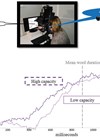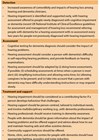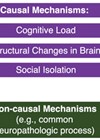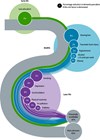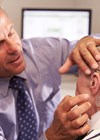Audiology features
Promoting human rights of deaf communities in low-resource settings
Stigma and misconceptions about deafness are serious impediments for many deaf people to realise rights and potential in some of the most challenging situations globally. Around 430 million people are estimated to live with moderate or higher levels of hearing...
Mapping the financial and disease burden of hearing loss and associated interventions
The prevalence and burden of ear and hearing disorders is huge and, historically, has been underappreciated. Globally, unaddressed hearing loss poses a growing public health challenge, requiring urgent attention from policymakers, health professionals and civil society. The recently published World...
Bringing ear care and hearing services to the hardest to reach: the potential of primary healthcare workers
Can workers from the local community plug the workforce gap in providing ear and hearing care? Bringing ear and hearing care services closer to the community remains a key component of reducing the burden of ear and hearing conditions across...
Use of automated audiometry for faster patient access to audiology services?
Manual audiometry has long been the gold standard for establishing hearing thresholds. In recent years, a number of automated audiometry applications have reached the market. In this article, a team from Ireland have put a version of automated audiometry to...
Are today’s implantable hearing devices better than conventional devices for patients with conductive and mixed hearing loss?
In March 2014, we published a paper in ENT & Audiology News, with a similar title. Below, an updated overview is presented of available devices (early 2021) for patients with conductive/mixed hearing loss. The focus is on effectiveness. Patients with...
Addressing the hearing needs of people with dementia
Dr Dawes provides a comprehensive overview of hearing needs of persons with dementia coupled with recommended guidelines for hearing-related considerations when assessing and intervening with persons with dementia. With ageing populations, we face a global dementia challenge. Rates of both...
Hearing loss and cognition: something to think about
Irace, Chern and Golub propose causal and non-causal mechanisms for the links between hearing loss and dementia, concluding with a discussion of several proactive measures available to help preserve neurocognitive health in older adults with hearing loss. What is age-related...
2020 Lancet Commission on dementia: a call to action for integrated hearing healthcare
Dr Georgiou’s summary of the 2020 update to the 2017 Lancet Commission underscores the importance of medical and hearing healthcare professionals working together to tackle the modifiable risk factors that affect individuals throughout their lives, to help delay or even...
Cognition and hearing – you can’t test one with the other!
Cognitive Psychologist, Boaz M Ben-David, provides insights into the import of considering cognitive factors when assessing speech perception ability to maximise intervention success. Failing to do so, he suggests, is “ageist”, a predisposition healthcare professionals must avoid. Cognitive performance is...
Working with people with hearing loss and dementia
A member of the SENSE-Cog team in the UK, Dr Littlejohn provides an overview of multidisciplinary recommendations for diagnosis, management and care of older adults with hearing loss, vision loss and dementia. She underscores how consideration of hearing status when...
My experience of implementing remote care during COVID-19
When the COVID-19 pandemic hit, it is safe to say very few audiology services were fully prepared for the challenges it would pose. Gina Angley, Associate Director Adult Amplification Program, Vanderbilt University, tells us about her experience of preparing her...
Privacy and security in connected hearing healthcare
The COVID-19 pandemic has forced audiology services across the globe to find new ways of working. This has resulted in a rapid increase in the uptake of remote care and, with it, some new privacy and security considerations. Connected hearing...





